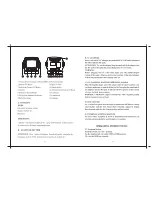
Danger from
escaping shield-
ing gas
Risk of suffocation from the uncontrolled escape of shielding gas
Shielding gas is colourless and odourless and, in the event of a leak, can displace the
oxygen in the ambient air.
-
Ensure an adequate supply of fresh air with a ventilation rate of at least 20 m³/hour.
-
Observe safety and maintenance instructions on the shielding gas cylinder or the
main gas supply.
-
Close the shielding gas cylinder valve or main gas supply if no welding is taking
place.
-
Check the shielding gas cylinder or main gas supply for uncontrolled gas leakage
before every start-up.
Safety measures
in normal opera-
tion
Only operate the device when all safety devices are fully functional. If the safety devices
are not fully functional, there is a risk of
-
injury or death to the operator or a third party
-
damage to the device and other material assets belonging to the operator
-
inefficient operation of the device
Any safety devices that are not functioning properly must be repaired before switching on
the device.
Never bypass or disable safety devices.
Before switching on the device, ensure that no one is likely to be endangered.
Check the device at least once a week for obvious damage and proper functioning of
safety devices.
Always fasten the shielding gas cylinder securely and remove it beforehand if the device
is to be transported by crane.
Only the manufacturer's original coolant is suitable for use with our devices due to its
properties (electrical conductibility, anti-freeze agent, material compatibility, flammability,
etc.).
Only use suitable original coolant from the manufacturer.
Do not mix the manufacturer's original coolant with other coolants.
Only connect the manufacturer's system components to the cooling circuit.
The manufacturer accepts no liability for damage resulting from use of other system
components or a different coolant. In addition, all warranty claims will be forfeited.
Cooling Liquid FCL 10/20 does not ignite. The ethanol-based coolant can ignite under
certain conditions. Transport the coolant only in its original, sealed containers and keep
well away from any sources of ignition.
Used coolant must be disposed of properly in accordance with the relevant national and
international regulations. The coolant safety data sheet may be obtained from your ser-
vice centre or downloaded from the manufacturer's website.
Check the coolant level before starting to weld, while the system is still cool.
Commissioning,
maintenance and
repair
It is impossible to guarantee that bought-in parts are designed and manufactured to meet
the demands made of them, or that they satisfy safety requirements.
15
EN
Summary of Contents for TransSteel 2700c
Page 2: ......
Page 18: ...18...
Page 19: ...General information 19...
Page 20: ...20...
Page 26: ...VRD is active again The output voltage is limited to 35 V once more 26...
Page 27: ...Control elements and connections 27...
Page 28: ...28...
Page 37: ...Installation and commissioning 37...
Page 38: ...38...
Page 62: ...62...
Page 63: ...Welding 63...
Page 64: ...64...
Page 78: ...Number 2 Number 3 Number 4 Number 5 78...
Page 79: ...Setup settings 79...
Page 80: ...80...
Page 91: ...10 Fit the gas nozzle back onto the welding torch 91 EN...
Page 93: ...Troubleshooting and maintenance 93...
Page 94: ...94...
















































